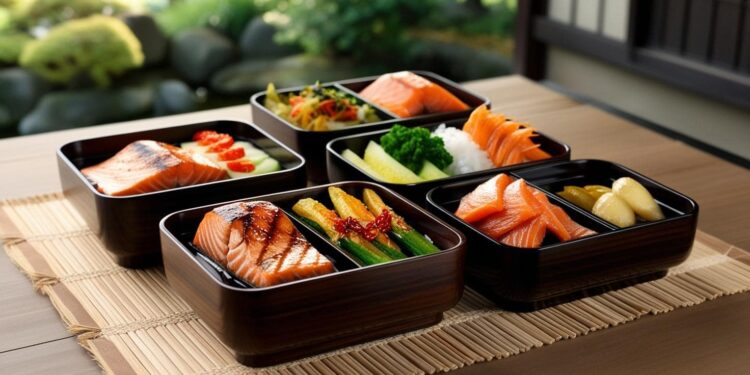Introduction: More Than Just a Lunchbox
Japanese Bento: If you’ve ever admired the neat, colorful compartments of a Japanese bento box, you may have noticed there’s something more than just aesthetics at play. The bento box .. a single-portion, home-packed meal.. has captivated people around the world not just for its practicality, but for the deeper meaning it carries. From a symbol of love and care to a showcase of culinary discipline, the bento encapsulates order, affection, and cultural identity in every bite.
In this article, we’ll explore the meaning behind bento, uncover its cultural roots, and provide tips on how you can incorporate this thoughtful tradition into your everyday meals.
The Cultural Roots of Bento: Japanese Bento
The term bento (弁当) originated from a Southern Song Dynasty word meaning “convenient,” and was adapted into Japanese culture during the Kamakura period (1185–1333). Initially, bento referred to meals packed in simple bamboo or wooden boxes, ideal for travelers, workers, and warriors. Over time, bento changed and became more detailed, especially during the Edo and Meiji periods, when people began to focus more on using seasonal ingredients and making the meals look more beautiful.
Today, bento is a fixture of Japanese life .. from homemade school lunches and train station meals (ekiben) to gourmet offerings in department stores. Each one speaks volumes about tradition, mindfulness, and presentation.
Order in a Box: The Aesthetic and Nutritional Balance
A key feature of a traditional bento is how it’s balanced in both nutrition and appearance.. The Japanese principle of “goshiki” (five colors).. red, yellow, green, white, and black, is often applied to ensure variety and health. In the same way, the ‘rule of five’, five colors, five flavors, and five cooking styles.. helps decide what foods to include and how to arrange them.
Keyword Tip: If you’re searching for “healthy bento box ideas” or “balanced lunch box meals,” learning this method can elevate your meal prep game.
Each section of the bento is intentional:
- Rice or noodles provide a satisfying base.
- Proteins like tamagoyaki (rolled omelet), fish, or chicken offer sustenance.
- Vegetables and pickles bring color, texture, and different flavors to the meal.
The result? A compact, satisfying meal that feeds the body and soothes the soul.
A Gesture of Love and Care
In Japanese households, bento-making is often a labor of love. Parents, especially mothers, are known to wake up early to prepare adorable “kyaraben” (character bento) for their children, shaping rice and vegetables into animals, cartoon characters, or seasonal motifs. This goes beyond nutrition, it’s a non-verbal way of expressing affection, encouragement, and attention to detail.
Even among adults, offering someone a bento can convey thoughtfulness and appreciation. In a fast-paced world, the act of preparing and presenting a bento signifies slowing down and valuing relationships.
Bento as a Reflection of Japanese Culture
A traditional bento embodies several core values of Japanese culture:
- Discipline and mindfulness – every item is carefully chosen and placed.
- Minimalism – no space is wasted, and simplicity is cherished.
- Harmony with nature – seasonal ingredients are often used to align with nature’s rhythm.
Whether you’re eating a store-bought ekiben on a bullet train or a lovingly prepared homemade bento, you’re partaking in a cultural ritual that emphasizes connection, care, and mindfulness.
Bringing Bento into Your Daily Life: Actionable Tips
Want to incorporate bento philosophy into your own meals? Here are some tips to get started:
- Plan your meals to mix different proteins, vegetables, and grains.
- Think in Compartments: Even if you’re not using a traditional bento box, mentally divide your plate or lunch container into sections.
- Use Leftovers Creatively: Yesterday’s grilled chicken or steamed vegetables can find a second life in your bento.
- Add a Personal Touch: A handwritten note, a fun food pick, or a themed lunch can make a big impact.
- Pick fruits and veggies that are in season, they taste better and are healthier.
Check out our Beginner’s Guide to Japan’s Must-Try Street Foods: Flavors of the Streets
Conclusion: A Box Full of Meaning
The next time you see or prepare a bento, take a moment to appreciate the layers beyond the ingredients. It’s not just a meal.. It’s a message of care, a lesson in balance, and a snapshot of Japanese culture.
Whether you’re packing a lunch for a loved one or simply seeking a more intentional way to eat, adopting the bento mindset can transform your approach to food and relationships.
Start Your Bento Journey Today!
Ready to bring more intention, love, and creativity to your meals?










































